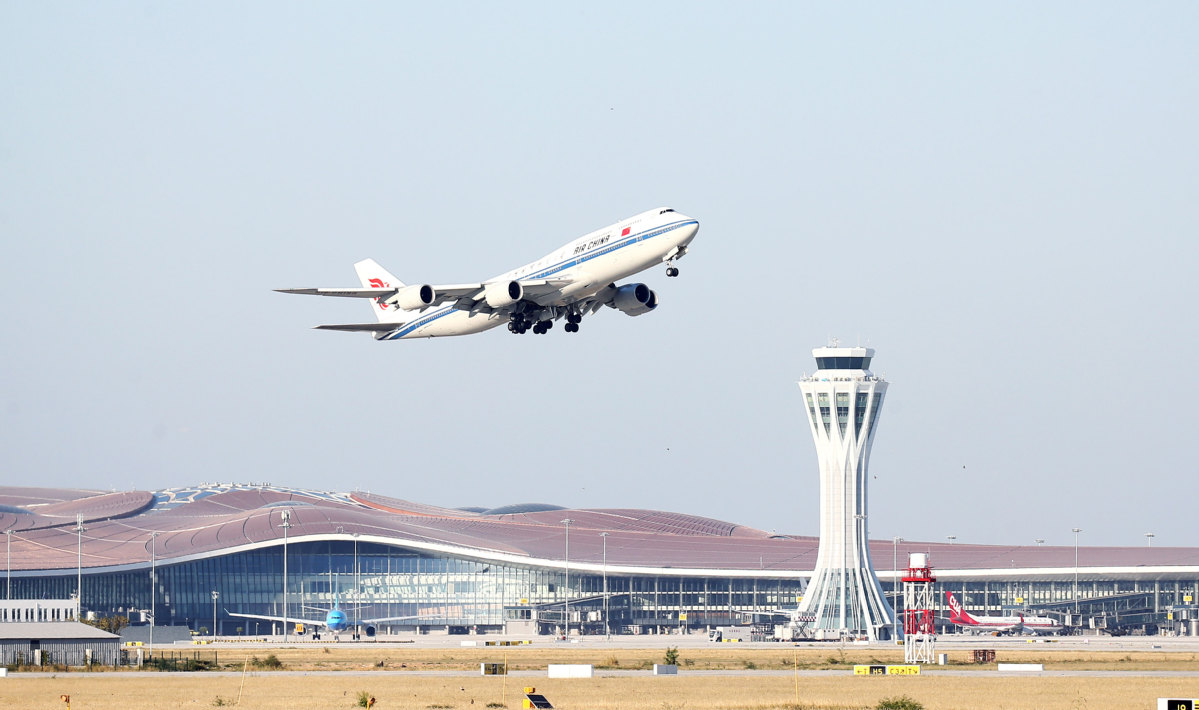International aviation to take off again

An Air China plane takes off from Beijing Daxing International Airport on Sept 25, 2019. [Photo by Zou Hong/chinadaily.com.cn]
On Monday the National Health Commission announced that the novel coronavirus pneumonia is renamed as novel coronavirus infection, and that China will downgrade management of the disease from Class A to Class B in accordance with the Law on Prevention and Treatment of Infectious Disease, starting from Jan 8.
On Tuesday, the State Council joint prevention and control mechanism against COVID-19 announced that passengers traveling to China need to take nucleic acid test within 48 hours before boarding their flights to China, but nucleic acid screenings and centralized isolation after arrival will be canceled.
The new rules suggest the international aviation industry can expect to be on the road to recovery soon.
The circuit breaker mechanism has been in place for almost two and a half years, as the government initiated the move on June 8, 2020, to restrict the number of inbound flights. Based on data from DAST, an online travel agency, due to the circuit breaker policy, international passenger traffic to China dropped to a gloomily low level with less than 1,100 inbound flights a month at the most (equivalent to less than 37 inbound flights per day). Also, 1,963 inbound flights were suspended temporarily from June 2020 to July 2022.
Worse, up to 1,247 inbound flights were suspended or restricted in 2022 (by the end of July), accounting for about 63.5 percent of the total inbound flights suspended or restricted during the pandemic. As the above data show, China's civil aviation market has been down for several years due to flight suspensions and/or restrictions.
But since new rules to optimize the prevention and control measures since early November, many airlines, both domestic and foreign, are working out new flight schedules in order to cash in on the “opening-up” of China's aviation market again. As for the Civil Aviation Administration of China, it will implement its 2022-23 winter-spring season flight schedule from late October 2022 to March 2023.
With the situation improving, albeit slowly, the international aviation sector is looking to tap the dormant potential of the Chinese aviation market by operating about 420 scheduled inbound passenger flights a week (about 60 inbound flights a day). Leading airlines including Air China, China Southern and China Eastern plan to operate on 52, 42 and 42 international routes respectively.
Taking Air China and China Southern as examples, the number of international routes scheduled for 2022-23 winter-spring season has increased significantly compared with the 2022 summer-autumn season. In addition, China Southern resumed international passenger flights including one from Guangzhou to New York from Dec 1, resuming return flights from Dec 3, although for long, China Southern operated flights only between Guangzhou and Los Angeles in the American civil aviation market since 2020.
These facts portend a prosperous aviation market is on its way. But the facts also mean that airports will need to make adequate preparations to face the existent and emerging challenges. Along with the brighter prospects, the aviation industry also faces many challenges. To begin with, easing the pandemic prevention and control measures doesn't necessarily mean the flights and airports become safe automatically. On the contrary, the increase in international passenger flow has put greater pressure on anti-pandemic work at airports.
Besides, the mentality, demand and attitude of passengers toward air travel in the post-pandemic era, as well as the market structure and the airlines' operational demand have changed. Whether airports can effectively adapt to these changes and respond to the new challenges are also important issues for airport operators and managers.
However, the easing of anti-pandemic restrictions will play a positive role in increasing international aviation traffic and the number of air passengers, which in turn will accelerate the recovery of airlines around the world and benefit global aviation hubs in China including Beijing, boost the airport economy and promote regional development.
It has been more than two and a half years since Daxing airport suspended international flights. Daxing is a global leader in terminal design, and has central radial finger gallery structure and automation facilities that make transit, both domestic and international, much easier. In fact, in terms of minimum connecting time, Daxing is one of the world leaders.
Before the pandemic broke out, Daxing airport planned to have in place a relatively complete international airline network. It had made serious efforts to turn the airport into a global transit hub, which could share codes and engage in international airline alliance cooperation. And now that the government has cancelled the circuit breaker mechanism, we can expect the aviation industry as a whole to benefit from the decision – for example, Daxing airport can be expected to resume international flights.
The new rules bring hopes to China's aviation sector, which will contribute to the faster recovery of the world aviation market.
Wu Di is supervisor of Planning and Development Department, Beijing Daxing International Airport, and Su Yiming, supervisor of Aviation Business Department, Beijing Daxing International Airport.
Photos
Related Stories
- China's Zhuhai to hold first AERO Asia show
- Frontier Chinese aviation, aerospace technologies displayed at Airshow China 2022
- ICAO calls on aviation regulators to productively engage with innovators
- Naval aviation brigade conducts air combat training exercise
- Aviation Sports Tourism Festival kicks off in Jiangxi
Copyright © 2022 People's Daily Online. All Rights Reserved.









